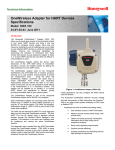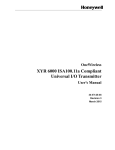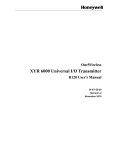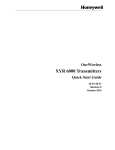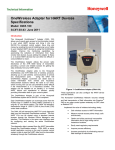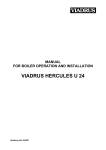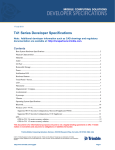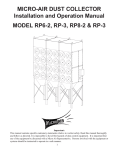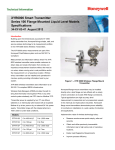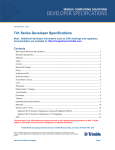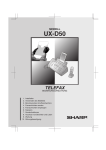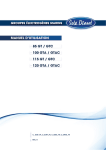Download OWA 100 OneWireless Adapter User Manual
Transcript
OneWireless OWA 100 OneWireless Adapter User Manual 34-XY-25-40 Revision 2 July 2011 Notices and Trademarks Copyright 2011 by Honeywell International Inc. Revision 2 July 2011 While this information is presented in good faith and believed to be accurate, Honeywell disclaims the implied warranties of merchantability and fitness for a particular purpose and makes no express warranties except as may be stated in its written agreement with and for its customers. In no event is Honeywell liable to anyone for any indirect, special or consequential damages. The information and specifications in this document are subject to change without notice. Honeywell, PlantScape, Experion PKS, and TotalPlant are registered trademarks of Honeywell International Inc. ® HART is a trademark of the Hart Communication Foundation. Other brand or product names are trademarks of their respective owners. Honeywell Process Solutions 1860 West Rose Garden Lane Phoenix, AZ 85027 ii OWA 100 Adapter User Manual Rev. 2 July 2011 About This Document This document describes mounting, installation, wiring, operation and maintenance of the OWA 100 Wireless Adapter are covered in other documents. Honeywell does not recommend using devices for critical control where there is a single point of failure or where single points of failure result in unsafe conditions. OneWireless is targeted at open loop control, supervisory control, and controls that do not have environmental or safety consequences. As with any process control solution, the end-user must weigh the risks and benefits to determine if the products used are the right match for the application based on security, safety, and performance. Additionally, it is up to the end-user to ensure that the control strategy sheds to a safe operating condition if any crucial segment of the control solution fails. Revision Information Document Name Document ID Revision Number Publication Date OWA 100 Adapter User Manual 34-XY-25-40 1 January 2011 Release version 34-XY-25-40 2 July 2011 References The following list identifies all documents that may be sources of reference for material discussed in this publication. Document Title Getting Started with Honeywell OneWireless Solutions OneWireless Wireless Builder User’s Guide OneWireless Builder Parameter Reference Support and contact info United States and Canada Contact: Honeywell Process Solution Global Technical Support: Phone 1-800 423-9883. Honeywell Field Solutions Customer Support: Phone 1-800-343-0228 Calls are answered by dispatcher between 6:00 am and 4:00 pm Mountain Standard Time. Emergency calls outside normal working hours are received by an answering service and returned within one hour. Outside US: Phone 001-215/641-3610 Email: [email protected] Mail: Honeywell Process Solutions 1860 West Rose Garden Lane Phoenix, AZ, 85027 Rev. 2 July 2011 OWA 100 Adapter User Manual iii Europe Contact: Phone: Facsimile: Mail: Honeywell TAC-EMEA +32-2-728-2732 +32-2-728-2696 TAC-BE02 Hermes Plaza Hermeslaan, 1H B-1831 Diegem, Belgium Contact: Phone: Honeywell Global TAC – Pacific 1300-300-4822 (toll free within Australia) +61-8-9362-9559 (outside Australia) +61-8-9362-9564 Honeywell Limited Australia 5 Kitchener Way Burswood 6100, Western Australia [email protected] Pacific Facsimile: Mail: Email: India Contact: Phone: Facsimile: Mail: Email: Honeywell Global TAC – India +91-20- 6603-9400 +91-20- 6603-9800 Honeywell Automation India Ltd. 56 and 57, Hadapsar Industrial Estate Hadapsar, Pune –411 013, India [email protected] Korea Contact: Phone: Facsimile: Mail: Email: Honeywell Global TAC – Korea +82-2-799-6317 +82-11-9227-6324 +82-2-792-9015 Honeywell Co., Ltd 17F, Kikje Center B/D, 191, Hangangro-2Ga Yongsan-gu, Seoul, 140-702, Korea [email protected] People’s Republic of China Contact: Honeywell Global TAC – China Phone: +86- 21-5257-4568 Mail: Honeywell (China) Co., Ltd 33/F, Tower A, City Center, 100 Zunyi Rd. Shanghai 200051, People’s Republic of China Email: [email protected] iv OWA 100 Adapter User Manual Rev. 2 July 2011 Singapore Contact: Phone: Facsimile: Mail: Email: Honeywell Global TAC – South East Asia +65-6580-3500 +65-6580-3501 +65-6445-3033 Honeywell Private Limited Honeywell Building 17, Changi Business Park Central 1 Singapore 486073 [email protected] Taiwan Contact: Phone: Facsimile: Mail: Email: Honeywell Global TAC – Taiwan +886- 7- 536-2567 +886-7-536-2039 Honeywell Taiwan Ltd. 17F-1, No. 260, Jhongshan 2nd Road. Cianjhen District Kaohsiung, Taiwan, ROC [email protected] Japan Contact: Phone: Facsimile: Mail: Email: Honeywell Global TAC – Japan +81-3-6730-7160 +81-3-6730-7228 Honeywell Japan Inc. New Pier Takeshiba, South Tower Building, 20th Floor, 1-16-1 Kaigan, Minato-ku, Tokyo 105-0022, Japan [email protected] World Wide Web Honeywell Solution Support Online: http://www.honeywell.com/ps Elsewhere Outside US: Phone 001-215/641-3610 or call your nearest Honeywell office. Training Classes Honeywell Automation College: http://www.automationcollege.com Rev. 2 July 2011 OWA 100 Adapter User Manual v Symbol Definitions The following table lists those symbols used in this document to denote certain conditions. Symbol Definition ATTENTION: Identifies information that requires special consideration. TIP: Identifies advice or hints for the user, often in terms of performing a task. CAUTION Indicates a situation which, if not avoided, may result in equipment or work (data) on the system being damaged or lost, or may result in the inability to properly operate the process. CAUTION: Indicates a potentially hazardous situation which, if not avoided, may result in minor or moderate injury. It may also be used to alert against unsafe practices. CAUTION symbol on the equipment refers the user to the product manual for additional information. The symbol appears next to required information in the manual. ESD HAZARD: Danger of an electro-static discharge to which equipment may be sensitive. Observe precautions for handling electrostatic sensitive devices. Protective Earth (PE) terminal: Provided for connection of the protective earth (green or green/yellow) supply system conductor. continued Symbol Description ® The Factory Mutual Approval mark means the equipment has been rigorously tested and certified to be reliable. The Canadian Standards mark means the equipment has been tested and meets applicable standards for safety and/or performance. The Ex mark means the equipment complies with the requirements of the European standards that are harmonised with the 94/9/EC Directive (ATEX Directive, named after the French "ATmosphere EXplosible"). For radio equipment used in the European Union in accordance with the R&TTE Directive the CE Mark and the notified body (NB) identification number is used when the NB is involved in the conformity assessment procedure. The alert sign must be used when a restriction on use (output power limit by a country at certain frequencies) applies to the equipment and must follow the CE marking. vi OWA 100 Adapter User Manual Rev. 2 July 2011 Symbol Description The C-Tick mark is a certification trade mark registered to ACMA (Australian Communications and Media Authority) in Australia under the Trade Marks Act 1995 and to RSM in New Zealand under section 47 of the NZ Trade Marks Act. The mark is only to be used in accordance with conditions laid down by ACMA and RSM. This mark is equal to the CE Mark used in the European Union. N314 directly under the logo is Honeywell’s unique supplier identification number. Brazil – National Agency for telecommunications Rev. 2 July 2011 OWA 100 Adapter User Manual vii Contents Support and contact info .......................................................................................................................iii 1. INTRODUCTION .................................................................................................... 1 1.1 Safety Messages ...........................................................................................................................1 Warnings................................................................................................................................................................ 1 1.2 Purpose ..........................................................................................................................................1 1.3 Scope..............................................................................................................................................1 1.4 OneWireless network overview ...................................................................................................1 1.5 About the OWA 100 OneWireless Adapter .................................................................................2 Outputs .................................................................................................................................................................. 2 2. SPECIFICATIONS ................................................................................................. 3 2.1 European Union Usage.................................................................................................................3 2.2 Certifications and approvals........................................................................................................4 Provisioning Device ............................................................................................................................................... 5 2.3 Agency compliance information..................................................................................................6 FCC compliance statements .................................................................................................................................. 6 IC compliance statements...................................................................................................................................... 6 Radio Frequency (RF) statement........................................................................................................................... 6 European Union Conformity................................................................................................................................... 6 2.4 Honeywell European (CE) Declaration of Conformity (DoC) ....................................................7 2.5 IECEx Conditions of Certification: ..............................................................................................9 2.6 ATEX Conditions for Safe Use:....................................................................................................9 3. CONFIGURATION ............................................................................................... 10 3.1 Safety Messages .........................................................................................................................10 Warnings.............................................................................................................................................................. 10 3.2 Installation ...................................................................................................................................11 Dimensions .......................................................................................................................................................... 12 3.3 Connecting to network ...............................................................................................................13 3.4 Configuration...............................................................................................................................13 4. OPERATION ........................................................................................................ 18 4.1 Overview ......................................................................................................................................18 OWA 100 Adapter display modes ........................................................................................................................ 18 4.2 Provisioning device menus........................................................................................................20 Overview .............................................................................................................................................................. 20 Main menu ........................................................................................................................................................... 20 Security and Node Deployment ........................................................................................................................... 21 Device Local Configuration .................................................................................................................................. 23 Read Node Information ........................................................................................................................................ 24 Advanced Options................................................................................................................................................ 26 viii OWA 100 Adapter User Manual Rev. 2 July 2011 Contents 5. MAINTENANCE/REPAIR .................................................................................... 28 5.1 Parts .............................................................................................................................................28 5.2 Replacing the battery..................................................................................................................28 When to replace ...................................................................................................................................................28 Tools required ......................................................................................................................................................28 Procedure.............................................................................................................................................................28 6. CERTIFICATION INSTALLATION REQUIREMENTS......................................... 31 6.1 7. Certification Drawings ................................................................................................................31 REFERENCE DATA ............................................................................................ 33 7.1 Product Specifications ...............................................................................................................33 Operating Conditions............................................................................................................................................33 Specifications .......................................................................................................................................................33 Physical Specifications .........................................................................................................................................34 Certifications.........................................................................................................................................................35 Rev. 2 July 2011 OWA 100 Adapter User Manual ix Contents Tables Tables Table 1 OWA 100 Adapter Display Modes..................................................................................................18 Table 2 Buttons for Device Local Configuration ..........................................................................................23 Table 3 Read Node Information ..................................................................................................................24 Table 4 Advanced Options ..........................................................................................................................27 Table 5 Battery replacement procedure ......................................................................................................30 Figures Figure 1-1 OWA 100 Adapter Functional Diagram.......................................................................................2 Figure 3-1 Installation, Front view ...............................................................................................................11 Figure 3-2 Installation, Back view................................................................................................................11 Figure 3-3 Dimensions.................................................................................................................................12 Figure 3-4 System Wiring Diagram .............................................................................................................12 Figure 3-5 OWA 100 – TWO-WIRE CONFIGURATION .............................................................................13 Figure 3-6 OWA 100 – TWO-WIRE CONFIGURATION WITH RESISTOR ...............................................14 Figure 3-7 OWA 100 – 4-WIRE PASSIVE DEVICE CONFIGURATION.....................................................14 Figure 3-8 OWA 100 – 4-WIRE PASSIVE DEVICE CONFIGURATION WITH RESISTOR .......................15 Figure 3-9 OWA 100 – 4-WIRE ACTIVE DEVICE CONFIGURATION .......................................................15 Figure 3-10 OWA 100 – 4-WIRE ACTIVE DEVICE CONFIGURATION WITH NO 4-20 mA LOOP...........16 Figure 3-11 OWA 100 – AS A ROUTER, NO WIRED DEVICE ..................................................................16 Figure 3-12 REMOTE INSTALLATION .......................................................................................................17 Figure 4-1 Main menu..................................................................................................................................20 Figure 4-2 Security and Node Deployment .................................................................................................21 Figure 4-3 Device Local Configuration screen ............................................................................................23 Figure 4-4 Read Node Information ..............................................................................................................24 Figure 4-5 Advanced Options ......................................................................................................................26 Figure 5-1 Battery replacement ...................................................................................................................29 x OWA 100 Adapter User Manual Rev. 2 July 2011 1. Introduction 1.1. Safety Messages 1. Introduction 1.1 Safety Messages These instruction procedures may require special precautions to ensure the safety of the personnel performing the operations. Information that potentially raises safety issues is indicated by a warning symbol ( ). Please refer to the following safety messages before performing an operation preceded by this symbol. WARNING Warnings Failure to follow these instructions could result in death or serious injury. • Make sure only qualified personnel perform the installation. Explosions could result in death or serious injury. • Before connecting the OWA 100 OneWireless Adaptor in an explosive atmosphere, make sure the instruments are installed in accordance with intrinsically safe or nonincendive field wiring practices. • Verify that the operating atmosphere of the transmitter is consistent with the appropriate hazardous locations certifications. Electrical shock could cause death or serious injury. • Use extreme caution when making contact with the leads and terminals. 1.2 Purpose This manual describes the Honeywell OneWireless OWA 100 Adapter installation, function, operation and maintenance. 1.3 Scope The manual includes: 1.4 Details of topics that relate uniquely to the Honeywell OWA 100 Adapter This manual covers installation, mounting and wiring of the OneWireless OWA 100 Adapter. OneWireless network overview OneWireless is an all digital, serial, two-way communication mesh network that interconnects industrial field sensors to a central system. OneWireless has defined standards to which field devices and operator stations communicate with one another. The communications protocol is built as an "open system" to allow all field devices and equipment that are built to OneWireless standard to be integrated into a system, regardless of the device manufacturer. This interoperability of devices using OneWireless technology is to become an industry standard for automation systems. Rev. 2 July 2011 OWA 100 Adapter User Manual 1 1. Introduction 1.5. About the OWA 100 OneWireless Adapter 1.5 About the OWA 100 OneWireless Adapter The OneWireless Adapet (OWA 100) is designed with an OneWireless interface to allow wired HART devices to operate in a compatible distributed OneWireless system. The adapter will interoperate with any OneWireless-registered device and provide the HART diagnostic and process information to any ISA100.11a compliant system. The OWA 100 Adapter includes OneWireless electronics for operating in a 2.4GHz network. Outputs The Process Variable (PV) is available for monitoring and alarm purposes. Available PV update rates are 5, 10, 30, 60 seconds and are set via the OneWireless application. Slower update rates extend battery life. Figure 1 shows a block diagram of a OWA 100 Adapter’s operating functions. Figure 1-1 OWA 100 Adapter Functional Diagram 2 OWA 100 Adapter User Manual Rev. 2 July 2011 2. Specifications 2.1. European Union Usage 2. Specifications 2.1 European Union Usage This product may be used in any of the following European Union nations. ISO 3166 ISO 3166 Country Country 2 letter code 2 letter code Austria AT Latvia LV Belgium BE Liechtenstein LI Bulgaria BG Lithuania LT Cyprus CY Malta MT Czech Republic CZ Netherlands NL Denmark DK Norway NO Estonia EE Poland PL Finland FI Portugal PT France FR Romania RO Germany DE Slovakia SK Greece GR Slovenia SI Hungary HU Spain ES Iceland IS Sweden SE Ireland IE Switzerland CH Italy IT United Kingdom BG Rev. 2 July 2011 OWA 100 Adapter User Manual 3 2. Specifications 2.2. Certifications and approvals 2.2 Certifications and approvals Hazardous Location Certifications CSA - USA and Canada Intrinsic Safety Class I, II, III Division 1, Groups C, D, E, F, & G; T4 Ex ia IIB; T4; Ex tb IIIC T90°C IP66 Ambient Temperature: –40°C ≤ Ta ≤ +70°C Enclosure: Type 4x/ IP46 Non Incendive Class I, Division 2, Groups CD; Class II, Division 2, Groups F & G; Suitable for Class III, Division 2; T4 Class I, Zone 2 AEx nA IIB, T4 Ex tb IIIC T90°C, IP66 Ambient Temperature: –40°C ≤ Ta ≤ +85°C Enclosure: Type 4x/ IP46 IECEx DEKRA- Intrinsic Safety Ex ia IIB, T4 Ex tb IIIC T90°C, IP66 Ambient Temperature: –40°C ≤ Ta ≤ +70°C Enclosure: IP66 DEKRA- Non Sparking Ex nA IIB T4, Gc Zone 22, Ex tb IIIC T90°C IP66, Dc, Ambient Temperature: –40°C ≤ Ta ≤ +85°C Enclosure: IP66 4 OWA 100 Adapter User Manual Rev. 2 July 2011 2. Specifications 2.2. Certifications and approvals ATEX DEKRA- Intrinsic Safety II 1 G Ex ia IIB T4 II 1 D Ex tb IIIC T90°C, IP66 Ambient Temperature: –40°C ≤ Ta ≤ +70°C Enclosure: IP66 DEKRA- Non Sparking II 3 G Ex nA IIB T4 II 3 D Ex tb IIIC T90°C IP66 Ambient Temperature: –40°C ≤ Ta ≤ +85°C Enclosure: IP66 For detailed OWA 100 Adapter specifications see the following Specification and Model Selection Guide. OWA 100 Adapter (document 34-XY-03-43) Provisioning Device Install the Provisioning Device application on any PDA having Windows Mobile version 4.2+ Infrared port. Rev. 2 July 2011 OWA 100 Adapter User Manual 5 2. Specifications 2.3. Agency compliance information 2.3 Agency compliance information This section contains the Federal Communications Commission (FCC), Industry Canada (IC) and Radio Frequency compliance statements for the OneWireless Multinode device. ATTENTION OWA 100 ADAPTER 100 units must be professionally installed in accordance with the requirements specified in the OneWireless Agency Compliance Professional Installation Guide. FCC compliance statements This device complies with Part 15 of FCC Rules and Regulations. Operation is subject to the following two conditions: (1) This device may not cause harmful interference and (2) this device must accept any interference received, including interference that may cause undesired operation. This equipment has been tested and found to comply with the limits for a Class A digital device, pursuant to Part 15 of the FCC Rules. These limits are designed to provide reasonable protection against harmful interference in a residential installation. This equipment generates, uses, and can radiate radiofrequency energy and, if not installed and used in accordance with these instructions, may cause harmful interference to radio communications. Operation of this equipment in a residential area is likely to cause harmful interference in which case the user will be required to correct the interference at his own expense. Intentional or unintentional changes or modifications must not be made to the Multinode unless under the express consent of the party responsible for compliance. Any such modifications could void the user’s authority to operate the equipment and will void the manufacturer’s warranty. IC compliance statements To reduce potential radio interference to other users, the antenna type and its gain should be so chosen that the equivalent isotropic radiated power (EIRP) is not more than that permitted for successful communication. Operation is subject to the following two conditions: (1) this device may not cause interference, and (2) this device must accept any interference, including interference that may cause undesired operation of the device. This Class A digital apparatus complies with Canadian ICES-003. French: Cet appareil numérique de la classe A est conforme à la norme NMB-003 du Canada. Radio Frequency (RF) statement To comply with FCC’s and Industry Canada’s RF exposure requirements, the following antenna installation and device operating configurations must be satisfied. This device must not be co-located with any other antenna or OWA 100 Adapter device and have a separation distance of at least 20cm from all persons. European Union Conformity The OWA100 Wireless Transmitters are in conformity with the applicable portions of the ETSI standards as required by the R&TTE Directive 1999/5/EC. 6 OWA 100 Adapter User Manual Rev. 2 July 2011 2. Specifications 2.4. Honeywell European (CE) Declaration of Conformity (DoC) 2.4 Honeywell European (CE) Declaration of Conformity (DoC) This section contains the European Declaration of Conformity (DoC) statement for the OWA 100 OneWireless Adapter. Rev. 2 July 2011 OWA 100 Adapter User Manual 7 2. Specifications 2.4. Honeywell European (CE) Declaration of Conformity (DoC) 8 OWA 100 Adapter User Manual Rev. 2 July 2011 2. Specifications 2.5. IECEx Conditions of Certification: 2.5 IECEx Conditions of Certification: The enclosure is non-conducting and the area of the non-conducting part exceeds the maximum permissible areas for Zone 0, Gb according to IEC 60079-0. Therefore when it is used within a potentially explosive atmosphere, appropriate measures must be taken to prevent electrostatic discharge. 2.6 ATEX Conditions for Safe Use: The enclosure is non-conducting and the area of the non-conducting part exceeds the maximum permissible areas for Category II 1 G (Zone 0) Gb according to EN 60079-0. Therefore when it is used within a potentially explosive atmosphere, appropriate measures must be taken to prevent electrostatic discharge. Rev. 2 July 2011 OWA 100 Adapter User Manual 9 3. Configuration 3.1. Safety Messages 3. Configuration 3.1 Safety Messages These instruction procedures may require special precautions to ensure the safety of the personnel performing the operations. Information that potentially raises safety issues is indicated by a warning symbol ( ). Please refer to the following safety messages before performing an operation preceded by this symbol. Warnings WARNING – POTENTIAL ELECTROSTATIC CHARGING HAZARD The OWA 100 OneWireless Adaptor enclosure is non-conductive Lexan, EXL9330 Polycarbonate and may generate an ignition-capable level of electrostatic charge under certain extreme conditions. The user should ensure that the equipment is not installed in a location where it may be subjected to external conditions (such as high-pressure steam), which might cause a build-up of electrostatic charge on nonconducting surfaces. WARNING Failure to follow these instructions could result in death or serious injury. • Make sure only qualified personnel perform the installation. Explosions could result in death or serious injury. The OneWireless Adapter can only be opened for battery insertion and activation, or installed in a potentially hazardous location when the location is declared to be non-hazardous. • Before mounting the OneWireless Adapter to an existing field transmitter, verify that the instruments are installed in accordance with applicable intrinsically safe or nonincendive field wiring practices. • Verify that the certification parameters of the OneWireless Adapter are consistent with the appropriate hazardous locations certifications. Electrical shock could cause death or serious injury. • Use extreme caution when making contact with the leads and terminals. This device complies with Part 15 of the FCC Rules. Operation is subject to the following conditions: This device may not cause harmful interference. This device must accept any interference received, including interference that may cause undesired operation. This device must be installed to ensure a minimum antenna separation distance of 20 cm from all persons. 10 OWA 100 Adapter User Manual Rev. 2 July 2011 3. Configuration 3.2. Installation 3.2 Installation 1. Loosen the four M4 screws to remove the cover, (See Figure 3-1) If a new battery needs to be installed follow the directions for Replacing the Battery in Section 5.2. If a battery is installed remove the shipping tag between the battery and battery holder and replace the cover. Torque M4 screws to 1.0 N.m / 9.0 lbf-inch 2. Remove termination cover to which the adapter is to be connected. 3. Remove plastic protective cover on adapter hub 4. Insert wires through conduit entry of the unit to which it is to be mounted then start to thread the adapter hub into the conduit entry. Use the hex on the adapter hub (smaller hex - See Figure 3-2)) to securely tighten the adapter hub to the unit (See Note). To reorient the antenna of the adapter loosen the jam nut (Turn larger hex nut CC when looking at the front of the OWA 100 Adapter) and rotate the unit to the desired antenna location then retighten the jam nut to 9 N.m /7lb-foot. Note: The rotation of the unit is limited to 350 degrees. 5. Install the four wires per the OWA 100 Adapter Interconnection Diagram per Figure 3-5 to Figure 3-12. 6. Replace the termination cover. Note: It is the User/Installer's responsibility to install the 100 Adapter in accordance with the national and local code requirements. Figure 3-1 Installation, Front view Rev. 2 July 2011 Figure 3-2 Installation, Back view OWA 100 Adapter User Manual 11 3. Configuration 3.2. Installation Dimensions Figure 3-3 Dimensions Figure 3-4 System Wiring Diagram 12 OWA 100 Adapter User Manual Rev. 2 July 2011 3. Configuration 3.3. Connecting to network 3.3 Connecting to network Before the adapter can be configured it must be unlocked with a security key so it can join the network. Use the Provisioning Device Pocket PC software to receive security keys from the Key Server manager, then aim the Pocket PC at the OWA 100 Adapter and transmit a key. Use Provisioning Device to connect your OWA 100 Adapter to the OneWireless network, see section 4.2. See Getting Started with Honeywell OneWireless Solutions for more information. 3.4 Configuration The OWA 100 Adapter contains the electronics interface compatible for connecting to the OneWireless network. An operator uses the OneWireless application to configure blocks and to change operating parameters. These changes are written to the OWA 100 Adapter when it is authenticated by a security key. No local configuration of device is required. When configuring the OWA via the OneWireless application, the PV Publish rate of the OWA should be set to values between 5 seconds and one minute. Figure 3-5 OWA 100 – TWO-WIRE CONFIGURATION Rev. 2 July 2011 OWA 100 Adapter User Manual 13 3. Configuration 3.4. Configuration Figure 3-6 OWA 100 – TWO-WIRE CONFIGURATION WITH RESISTOR NOTE: A passive loop exists when the wired device is not supplying power to the 4-20mA loop. It is important to verify if the wired device is operating in the active or passive mode. Figure 3-7 OWA 100 – 4-WIRE PASSIVE DEVICE CONFIGURATION 14 OWA 100 Adapter User Manual Rev. 2 July 2011 3. Configuration 3.4. Configuration NOTE: A passive loop exists when the wired device is not supplying power to the 4-20mA loop. It is important to verify if the wired device is operating in the active or passive mode. Figure 3-8 OWA 100 – 4-WIRE PASSIVE DEVICE CONFIGURATION WITH RESISTOR NOTE: An active loop exists when the wired device is supplying power to the 4-20mA loop. It is important to verify if the wired device is operating in the active or passive mode. Figure 3-9 OWA 100 – 4-WIRE ACTIVE DEVICE CONFIGURATION Rev. 2 July 2011 OWA 100 Adapter User Manual 15 3. Configuration 3.4. Configuration Figure 3-10 OWA 100 – 4-WIRE ACTIVE DEVICE CONFIGURATION WITH NO 4-20 mA LOOP Figure 3-11 OWA 100 – AS A ROUTER, NO WIRED DEVICE 16 OWA 100 Adapter User Manual Rev. 2 July 2011 3. Configuration 3.4. Configuration Figure 3-12 REMOTE INSTALLATION Rev. 2 July 2011 OWA 100 Adapter User Manual 17 4. Operation 4.1. Overview 4. Operation 4.1 Overview OneWireless Adapter display modes The OneWireless Adapter contains one Red LED and one Green LED that are used to indicate status. LED Pattern HART Status Radio Status No LEDs Battery Low Battery Low Red – Red/Red NO HART NO KEY Green – Red/Red HART WORKING NO KEY Red – Green NO HART DISCOVER Green – Green HART WORKING DISCOVER Red – Red NO HART NOT CONNECTED Green – Red HART WORKING NOT CONNECTED Red – Red/Green NO HART SECURING Green – Red/Green HART WORKING SECURING Red – Green/Red NO HART JOINING Green – Green/Red HART WORKING JOINING Red – Green NO HART JOINED Green – Green HART WORKING JOINED Table 1 OWA 100 Adapter Display Modes OWA Status Definition What to do No LEDs No Power NO HART OWA cannot communicate with HART Device. Replace battery. Check wiring between HART device and OWA. Check for 4-20 mA on Loop connections. Check that HART Communications are enabled on the HART device. Check that HART device is operational. Check that voltage drop across HART device is within specifications – see HART device datasheet. Using a Secondary Master, confirm that HART Device will respond to HART messages. 18 OWA 100 Adapter User Manual Rev. 2 July 2011 4. Operation 4.1. Overview OWA Status Definition What to do HART WORKING OWA is communicating with HART Device. Normal Operation. NO KEY OWA does not have a Key Transmit a key to the OWA. See page 22. DISCOVER OWA has not made a connection to a FDAP and is in the Discovery Mode (searching for a connection to a FDAP). OWA will automatically enter a power saving mode if it cannot make a connection and will retry later. Wait for a connection. If OWA does not make a connection within five minutes, see NOT CONNECTED in this table. SECURING OWA has made a connection with the network and is validating its key. Wait for a connection. If OWA does not make a connection within five minutes, see NOT CONNECTED in this table. JOINING OWA is negotiating the parameters of its interface to the network. Wait for a connection. If OWA does not make a connection within five minutes, see NOT CONNECTED in this table. NOT CONNECTED OWA is in between Discovery attempts. If OWA does not make a connection to the wireless network within five minutes, do the following: Check that the Key is correct for the network that you are trying to join. Check that the FDAP(s) in the local area are turned on and are already a secure part of the network. Check that FDAP(s) are within radio range of OWA. Check if WDM is active and if the OWA shows up in the list of devices. JOINED OWA has made a secure connection with the network and has entered normal operation mode. Normal Operation. Rev. 2 July 2011 OWA 100 Adapter User Manual 19 4. Operation 4.2. Provisioning device menus 4.2 Provisioning device menus Overview Hold the Provisioning Device no more than 6” (15 cm) from the OWA 100 Adapter and aim the infrared beam at the OWA 100 Adapter window while tapping on the screen command or button. Main menu The main menu is shown below. Details start on the next page. Figure 4-1 Main menu 20 OWA 100 Adapter User Manual Rev. 2 July 2011 4. Operation 4.2. Provisioning device menus Security and Node Deployment Use this to: receive new security keys, transmit security keys for connecting the OWA 100 Adapter (or other nodes) to the OneWireless network, clear all security keys from the PDA, clear the OWA 100 Adapter’s key and reset its configuration to factory default (such as for decommissioning). Figure 4-2 Security and Node Deployment Rev. 2 July 2011 OWA 100 Adapter User Manual 21 4. Operation 4.2. Provisioning device menus To connect your OWA 100 Adapter to the OneWireless network perform the following steps. Step Action 1 If the PDA contains no keys, obtain new security keys from the Wireless Device Manager (WDM). 2 When the Provisioning Device has valid unexpired keys, aim it at the Infrared port of the OWA 100 Adapter and transmit a key to the OWA 100 Adapter. If the unit already has a key, first tap the Reset Device button and wait for the unit to reset and restart. When the unit does not have a key, tap the Provision Device button. The OWA 100 Adapter will validate the key and then use it to make a connection to the OneWireless Network. The OWA 100 Adapter may continue to show the diagnostic message “NO KEY” for a brief time while it validates the key before showing the “DISCOVER” message. To verify your OWA 100 Adapter has been authenticated, see the Connection prompt on the Read Node Info screen (page 24). To decommission your OWA 100 Adapter from the OneWireless network, select Reset Device to Defaults. This clears the OWA 100 Adapter’s key, network and security configurations, and resets the OWA 100 Adapter to its factory default settings. To do this perform the following steps. Select Clear Provisioning Data (under Options) when: The PDA has keys from one system, but you have moved your Provisioning Device to another system, or you want to clear all keys so that you cannot deploy any more keys without going to the key server manager and getting more. For more details on keys, refer to Getting Started with Honeywell OneWireless Solutions. 22 OWA 100 Adapter User Manual Rev. 2 July 2011 4. Operation 4.2. Provisioning device menus Device Local Configuration This display is not operative on the OWA 100 Adapter and is shown here for reference only. Figure 4-3 Device Local Configuration screen Table 2 Buttons for Device Local Configuration Button Function Enter the Menu Tree. Enter submenu of the menu that is appearing on the screen. Execute action. Submit the entered number while doing number entry. Read value of certain displayed parameters. Go to the next menu in the same level. View quick view parameters in Normal Display Sequence (PV Display). During number entry, increment the digit or change +/- sign. Go to the previous menu in the same level. View quick view parameters in Normal Display Sequence (PV Display). During number entry, decrement the digit or change +/- sign. Go to the upper menu level. When changing a number value, move cursor to the left/more significant digit, then wrap around to the least significant digit. Rev. 2 July 2011 OWA 100 Adapter User Manual 23 4. Operation 4.2. Provisioning device menus Read Node Information Use this to read the OWA 100 Adapter’s information shown in Figure 4-4. Figure 4-4 Read Node Information Table 3 Read Node Information Item 24 Description Tag Name: The name given to this transmitter Vendor: Manufacturer of device Model: Description of device Serial: This is the WBSN on the OWA 100 Adapter’s nameplate. Do not confuse this with the other nameplate item marked “Serial.” Radio Revsion: Software revision of radio firmware App Revision: Software revision of sensor firmware IP Address: IP Address of OWA 100 Adapter Network ID Wireless Network ID OWA 100 Adapter User Manual Rev. 2 July 2011 4. Operation 4.2. Provisioning device menus Item Join Status: Description The first line displays one of the following connection states. No Security Key – No security key has been deployed to the device or multinode. The user must give a security key to the device or multinode before it will join the wireless sensor network. Not Joined – A security key exists in the device or multinode, but no connection has been formed. The device or multinode is waiting to form a connection and will automatically retry shortly. Users may transmit a new security key in order to force the device or multinode to immediately retry to form a connection. Discover – The device is attempting to form a connection to the wireless sensor network. The device is discovering multinodes and, if a multinode is found, will transition to the securing state. Securing – The device is attempting to form a connection to the wireless sensor network. The device has discovered one or two multinodes and is attempting to form a secure session. If successful, the device will transition to the connected state. Joining – The device is negotiating the parameters of the wireless connection. Joined – A secure connection is formed with the network. The second line contains detailed state information useful for problem reporting. Rev. 2 July 2011 OWA 100 Adapter User Manual 25 4. Operation 4.2. Provisioning device menus Advanced Options Advanced options are non-typical configuration commands. Figure 4-5 Advanced Options 26 OWA 100 Adapter User Manual Rev. 2 July 2011 4. Operation 4.2. Provisioning device menus Table 4 Advanced Options Item Read TX Power Level Rev. 2 July 2011 Description Reads the transmission power level of the transmitter radio. OWA 100 Adapter User Manual 27 5. Maintenance/Repair 5.1 Parts The following replacement parts may be ordered from Honeywell. Part number Qty. Description 50056644-501 1 REMOTE MOUNTING KIT FOR 1/2 NPT OWA 100 ADAPTER 50056644-502 1 REMOTE MOUNTING KIT FOR M20 OWA 100 ADAPTER 30671907-001 1 PIPE MOUNT BRACKET KIT (SS) FOR MOUNTING OWA 100 ADAPTER 50026010-001 2 3.6V LITHIUM THIONYL CHLORIDE (Li-SOCI2) BATTERY 50026010-002 4 3.6V LITHIUM THIONYL CHLORIDE (Li-SOCI2) BATTERY 50026010-003 10 3.6V LITHIUM THIONYL CHLORIDE (Li-SOCI2) BATTERY 5.2 Replacing the battery When to replace When the Wireless System diagnostics for the OWA 100 Adapter shows a “Low Battery” message, you have 2-4 weeks to replace the battery beforeit expires. When the battery is removed or expired, all OWA 100 data is retained in the OWA 100 non-volatile memory. Tools required #1 Phillips Screwdriver and 3/16” Slotted Screwdriver Procedure ATTENTION The battery must be replaced only by a trained service technician. WARNINGS 28 Risk of death or serious injury by explosion. Do not open OWA 100 Adapter enclosure when an explosive gas atmosphere is present. The battery must not be changed in an explosive gas atmosphere. The batteries used in this device may present a risk of fire or chemical burn if mistreated. Do not recharge, disassemble, heat above 100°C (212°F), or incinerate. When installing the battery, do not snag the battery terminal on the clip or the battery may be damaged. Do not apply excessive force. Do not drop. Dropping the battery may cause damage. If a battery is dropped, do not install the dropped battery into the OWA 100 Adapter. Dispose of dropped battery promptly per local regulations or per the battery manufacturer’s recommendations. OWA 100 Adapter User Manual Rev. 2 July 2011 SHOCK HAZARD Depending on your installation, OWA 100 Adapter input wiring sources may contain high voltage. Disconnect all power from OWA 100 Adapter input sources before accessing the batteries. Failure to do so could result in death or serious injury if the input terminals or wires are accidentally touched. Figure 5-1 Battery replacement Rev. 2 July 2011 OWA 100 Adapter User Manual 29 Table 5 Battery replacement procedure Step Action ATTENTION Use only the following 3.6V lithium thionyl chloride (Li-SOCl2) batteries (non-rechargeable), size D. No other batteries are approved for use in OWA 100 Adapter. Xeno Energy XL-205F Eagle Picher PT-2300H Tadiran TL-5930/s 1 Loosen (4) M4 screws and remove the cover. 2 Disconnect J2 connector 3 Remove the old battery from the battery holder. If needed, pry out the battery by using a slotted screwdriver as a lever. 4 Reconnect J4 connector 5 Install battery as follows to avoid snagging the battery terminal on the clip and damaging the battery. Align the new battery with the clips and angle the positive (+) end of the batteryinto the positive (+) battery terminal clip. Using a thumb and forefinger pull the negative terminal clip outward and push down on the battery until fully seated in both clips. Do not apply excessive force when pushing the battery down. 30 6 Replace the cover and tighten the (4) M4 screws with a torque of 1.0 N.m / 9.0 lbf-inch. 7 Dispose the used battery promptly per local regulations or the battery manufacturer's recommendations. Keep away from children. Do not disassemble and do not dispose of in fire. OWA 100 Adapter User Manual Rev. 2 July 2011 6. Certification Installation Requirements 6.1 Certification Drawings Use the following drawings and accompanying notes and text for hazardous locations. Any deviation from the installation requirements could void the certification. For non-hazardous locations you can use the same drawings without the accompanying notes and text. Rev. 2 July 2011 OWA 100 Adapter User Manual 31 32 OWA 100 Adapter User Manual Rev. 2 July 2011 7. Reference Data 7.1 Product Specifications Operating Conditions Parameter Reference Condition °C Ambient Temperature** 25 ±1 Humidity (%RH) Rated Condition Operative Limits Transportation and Storage °F °C °F °C °F °C °F 77 ±2 -40 to 85 -40 to 185 -40 to 85 -40 to 185 -40 to 85 -40 to 185 10 to 55 0 to 100 Vibration Maximum of 4g over 15 to 200 Hz Shock Maximum of 40g 0 to 100 0 to 100 Battery powered 3.6V Lithium thionyl chloride (LiSOCl2) battery non rechargeable, size D Power Connected into a powered 4-20 mA loop power supply = 7 to 30 Vdc, 25 mA for power scavenging; maximum loop voltage drop due to adapter is 2.52 Vdc over the ambient temperature range across the loop; minimum loop load resistance is 250 Ohms. Battery life @ reference conditions with 30 second publish cycle time set for non-Routing is 3+ years ** The ambient limits shown are for ordinary non-hazardous locations only. Refer to the appropriate control drawing, FM/CSA, ATEX, or IECEx for the ambient limits when installed in hazardous locations. Specifications Parameter Description Input Any 2 or 4-wire HART device Wireless Communication ISA100.11a Compliant 2,400 to 2,4835 MHz (2.4 GHz) Industrial, Scientific and Medical (ISM) band per FCC 15.247 / IEEE 802.15.4–2006. Every data packet transmitted in either direction is verified (CRC check) and acknowledged by the receiving device. USA – FCC Certified; Canada – IC Certified; European Union – RTTE/ETSI Conformity RF Transmitter Power NA Selection – 125 mW (20.9 dBm) maximum transmit power not including antenna per FCC/IC, or 400 mW (26.0 dBm) maximum EIRP including antenna for USA and Canadian locations EU Selection – 10 mW (10.0 dBm) maximum EIRP including antenna per RTTE/ETSI for EU locations. Data PV Data Publish Cycle Time: Configurable from 5 second to 1 minute Rate: 250 Kbps ISA100.11a Compliant output Antenna Integral – 2.5 dBi omnidirectional monopole Signal Range* OWA 100 Adapter to FDAP: Nominal 305 m (1,000 feet) with a clear line of sight Two OWA's both having TX Power set to 14 dBm with a clear line of site nominal signal range is 240 m (790ft.) An XYR 6000 transmitter having TX Power set to 16 dBm and an OWA with TX Power set to 14 dBm with a clear line of site nominal signal range is 170 m (560ft.) Rev. 2 July 2011 OWA 100 Adapter User Manual 33 Parameter Routing vs. nonRouting" Specification - Unit can be set as a Field Routing or non-Field Routing device; the number of routing devices is set by the system manager. CE Conformity These transmitters conform with the protection requirements of European Council Directives: 2004/108/EC, the EMC Directive and 1999/5/EC, the Telecommunications Directive per EN 300 328, V1.7.1 (2004-11), EN 300 489-1, V1.6.1 (2005-09), EN 300 489-17, V1.2.1 (2002-08), EN 301 893 V1.4.1 and EN 61326-1:2005, Electrical Equipment for Measurement, Control and Laboratory Use – EMC Requirements Using the device as a routing device will impact battery life, the more messages routed through a device, the greater the impact on battery life. * Actual range can vary depending on site topography. Physical Specifications Parameter Description Mounting ½” NPT or M20 Stainless Steel fitting that allows the adapter to be attached directly to the conduit entry of any 2 or 4-wire HART device (standard options). Mounting should result in the antenna being vertically oriented. An optional Remote Mounting Kit is available. Housing Molded Lexan Polycarbonate V0 Rating and UV Stable. Meets NEMA 4X (hosedown and corrosion resistant), IP 66 (dust/tight/hosedown). Dimensions See Specification sheet. Net Weight Approximately 1.0lb/(0.45Kg) 34 OWA 100 Adapter User Manual Rev. 2 July 2011 Certifications Hazardous Location Certifications CSA – USA & Canada Intrinsic Safety Class I, II, III Division 1, Groups C, D, E, F, & G; T4 Ex ia IIB; T4; Ex tb IIIC T90°C IP66 Ambient Temperature: –40°C ≤ Ta ≤ +70°C Enclosure: Type 4x/ IP46 Non Incendive Class I, Division 2, Groups CD; Class II, Division 2, Groups F & G; Suitable for Class III, Division 2; T4 Class I, Zone 2 AEx nA IIB, T4 Ex tb IIIC T90°C, IP66 Ambient Temperature: –40°C ≤ Ta ≤ +85°C Enclosure: Type 4x/ IP46 IECEx - DEKRA Intrinsic Safety Ex ia IIB, T4 Ex tb IIIC T90°C, IP66 Ambient Temperature: –40°C ≤ Ta ≤ +70°C Enclosure: IP66 Non Sparking Ex nA IIB T4, Gc Zone 22, Ex tb IIIC T90°C IP66, Dc, Ambient Temperature: –40°C ≤ Ta ≤ +85°C Enclosure: IP66 ATEX - DEKRA Intrinsic Safety II 1 G Ex ia IIB T4 II 1 D Ex tb IIIC T90°C, IP66 Ambient Temperature: –40°C ≤ Ta ≤ +70°C Enclosure: IP66 Non Sparking II 3 G Ex nA IIB T4 II 3 D Ex tb IIIC T90°C IP66 Ambient Temperature: –40°C ≤ Ta ≤ +85°C Enclosure: IP66 Rev. 2 July 2011 OWA 100 Adapter User Manual 35 Sales and Service For application assistance, current specifications, pricing, or name of the nearest Authorized Distributor, contact one of the offices below. Asia Pacific Global Technical Support Field Instruments Phone: +65 6580 3156 Fax: +65 6445-3033 Australia Honeywell Limited Phone: +(61) 7-3846 1255 FAX: +(61) 7-3840 6481 Toll Free 1300-36-39-36 Toll Free Fax: 1300-36-04-70 China – PRC - Beijing Honeywell China Inc. Phone: +(86-10) 84583280 Fax: +(86-10) 8458-4650 China – PRC - Shanghai Honeywell China Inc. Phone: (86-21) 5257-4568 Fax: (86-21) 6237-2826 China – PRC - Chengdu Honeywell China Inc. Phone: +(86-28) 66135078 Fax: +(86-28) 8678-7061 China – PRC - Xi’an Honeywell China Ltd Xi’an. Phone: +(86-29) 88337490 Fax: +(86-29) 8833-7489 China – PRC - ShenzhenHoneywell China Inc. Phone: +(86) 755-25181226 Fax: +(86) 755-2518-1221 New Zealand Honeywell Limited Phone: +(64-9) 623-5050 Fax: +(64-9) 623-5060 Toll Free (0800) 202-088 Singapore Honeywell Pte Ltd. Phone: +(65) 6580 3278 Fax: +(65) 6445-3033 South Korea Honeywell Korea Co Ltd Phone: +(822) 799 6114 Fax: +(822) 792 9015 Thailand Honeywell Systems (Thailand) Ltd. Phone: +(662) 693-3099 FAX: +(662) 693-3089 Taiwan R.O.C. Honeywell Taiwan Ltd. Phone: +(886-2) 22451000 FAX: +(886-2) 2245-3243 SE Asia Countries see Honeywell Pte Ltd (Singapore) for: Philippines, Pakistan, Cambodia, Guam, Laos, Myanmar, Vietnam, East Timor SE Asia Countries see Honeywell Automation India Ltd for: Bangladesh Nepal Sri Lanka EUROPE Denmark Honeywell A/S Phone: +(45) 39 55 55 55 FAX: +(45) 39 55 55 58 Spain Honeywell S.A. Phone: +34 (0)91313 61 00 FAX: +34 (0)91313 61 30 Finland Honeywell OY Phone: +358 (0)20752 2753 FAX: +358 (0) 20752 2751 Sweden Honeywell AB Phone: +(46) 8 775 55 00 FAX: +(46) 8 775 56 00 France Honeywell SA Phone: +33 (0)1 60198075 FAX: +33 (0)1 60198201 Switzerland Honeywell AG Phone: +41 18552448 FAX: +(41) 1 855 24 45 Germany Honeywell AG Phone: +49 (69)8064-299 FAX: +49 (69)806497336 Turkey Honeywell Turkey A.S. Phone: +90 216 578 71 00 FAX: +90 216 575 66 35 Hungary Honeywell Kft. Phone: +36-1-451 4300 FAX: +36-1-451 4343 Ukraine Honeywell Tel: +380-44-201 44 74 Fax: +380-44-201-44-75 Italy Honeywell S.p.A. Phone:+390292146307 FAX: +39 0292146377 United Kingdom Honeywell Control Systems Ltd. Phone: +44 (0)1344 655251 FAX: +44 (0) 1344 655554 The Netherlands Honeywell B.V. Phone: +31 (0) 20 5656200 FAX: +31 (0) 20 5656210 Norway Honeywell A/S Phone: (45) 39 55 55 55 Poland Honeywell Sp. zo.o Phone: +48-22-6060900 FAX: +48-22-6060901 Portugal Honeywell Portugal Lda Phone: +351 21 424 5000 FAX: +351 21 424 50 99 Indonesia PT Honeywell Indonesia Phone: +(62) 21-535-8833 FAX: +(62) 21-5367 1008 Austria Honeywell Austria GmbH Phone: +43 (316)400123 FAX: +43 (316)40017 India Automation India Ltd. Honeywell Ltd. Phone:+(91) 6603-9400 Fax: +(91) 6603-9600 Belgium Honeywell SA/NV Phone:+32 (0)2728 24 07 FAX: +32 (0)2728 22 45 Japan Honeywell Inc. Phone: +(81) 3 6730 7197 Fax: +(81) 3 6730 7228 Bulgaria Honeywell EOOD Phone: +(359) 2 40 20 900 FAX: +(359) 2 40 20 990 Russian Federation (RF), Honeywell Field Solutions Kievskaya str., 7, Moscow 121059, Russia Phone +7 (495) 796 98 60 Fax +7 (495) 797 99 64 Czech Republic Honeywell spol. s.r.o. Phone:+420 242 442 232 FAX: +420 242 442 131 Slovak Republic Honeywell s.r.o. Phone: +421-2-58247 410 FAX: +421-2-58247 415 Malaysia Honeywell Engineering Sdn Bhd Phone: +(603) 7958-4788 Fax: +(603) 7958-8922 Romania Honeywell Bucharest Phone: +40 (0) 21 2316437 FAX: +40 (0) 21 2316439 MIDDLE EAST Abu Dhabi U A E Middle East Headquarters Honeywell Middle East Ltd. Phone: +971 2 4041246 FAX: +971 2 4432536 Sultanate of Oman Honeywell & Co Oman LLC Phone: +968 24 701153/ Ext.33 FAX +968 24 787351 Saudia Arabia Honeywell Turki Arabia Ltd Jubail Office Phone: +966-3-341-0140 Fax: +966-3-341-0216 Honeywell - ATCO Dammam Office Phone: 0096638304584 Fax: 0096638338059 Kuwait Honeywell Kuwait KSC Phone: +965 242 1327 to 30 Fax: +965 242 8315 And Phone: +965 326 2934/1821Fax: +965 326 1714 Honeywell Process Solutions 1860 West Rose Garden Lane Phoenix, Arizona 85027 www.honeywell.com/ps 34-XY-25-40 Rev.2 July 2011 2011 Honeywell International Inc. AFRICA Mediterranean & African Distributors Honeywell SpA Phone: +39 (02) 250 10 604 FAX: +39 (02) 250 10 659 South Africa (Republic of) and sub saharan Honeywell Southern Africa Honeywell S.A. Pty. Ltd. Phone: +27 11 6958000 FAX +27 118051504 NORTH AMERICA Canada Honeywell LTD Phone: 1-800-737-3360 FAX: 1-800-565-4130 USA Honeywell Process Solutions, Phone: 1-800-423-9883 Or 1-800-343-0228 Email: [email protected] SOUTH AMERICA Argentina Honeywell S.A.I.C. Phone: +(54-11) 4383-3637 FAX: +(54-11) 4325-6470 Brazil Honeywell do Brasil & Cia Phone: +(55-11) 7266-1900 FAX: +(55-11) 7266-1905 Chile Honeywell Chile, S.A. Phone: +(56-2) 233-0688 FAX: +(56-2) 231-6679 Mexico Honeywell S.A. de C.V. Phone: +(52) 55 5259-1966 FAX: +(52) 55 5570-2985 Puerto Rico Honeywell Inc. Phone: +(809) 792-7075 FAX: +(809) 792-0053 Trinidad Honeywell Inc. Phone: +(868) 624-3964 FAX: +(868) 624-3969 Venezuela Honeywell CA Phone: +(58-2) 238-0211 FAX: +(58-2) 238-3391














































